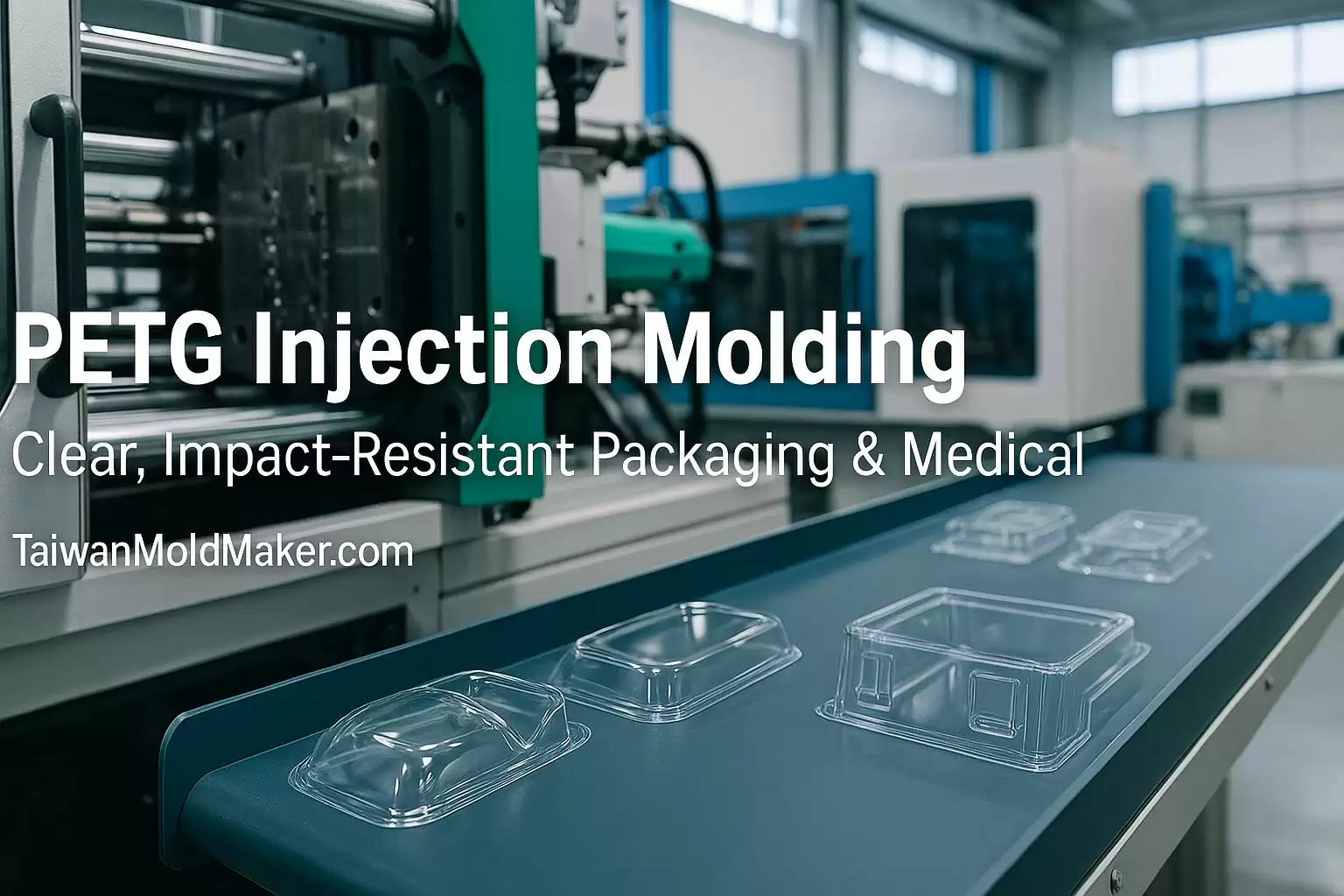Implement PETG Injection Molding for Clear, Impact-Resistant Packaging and Medical Items
Implement PETG Injection Molding for Clear, Impact-Resistant Packaging and Medical Items
PETG (polyethylene terephthalate glycol-modified) delivers the rare combination of glass-like clarity, high impact strength, and easy processing—making it a top choice for transparent packaging components, medical device housings, diagnostic cassettes, and display-grade consumer parts. With the right DFM and process window, PETG injection molding achieves crystal-clear cosmetics, reliable dimensions, and sterilization compatibility at scale. Here’s a practical guide—and how TaiwanMoldMaker.com gets you from prototype to validated production fast.
Why PETG over PC, PMMA, or PET?
| Property | PETG | PC | PMMA | PET (unmodified) |
|---|---|---|---|---|
| Clarity / Gloss | Excellent, water-clear | Good (slight tint) | Excellent | Crystalline haze in molding |
| Impact Strength | High | Very high | Moderate | Moderate |
| Chemical / Stress Crack | Good (check specific agents) | Good | Fair | Good but harder to process |
| Heat Resistance | ~70–80 °C HDT | Higher | Similar | Higher but needs care |
| Processing | Lower temps, easy flow | Higher temps | Brittle in molding | Crystallizes; narrow window |
| Sterilization (medical grades) | EtO, Gamma (grade-dependent) | EtO, limited Gamma | Typically EtO only | EtO, some Gamma |
Bottom line: choose PETG when optical clarity + impact matter more than high-heat exposure, and when you need fast, forgiving processing with beautiful surface quality.
Design Guidelines for Clear, Robust Parts
-
Wall Thickness: 0.8–3.0 mm for clear packaging and housings. Keep walls uniform to avoid sink and birefringence.
-
Ribs & Bosses: rib at 0.5–0.7× wall; fillet radii ≥ 0.5× wall to reduce stress whitening.
-
Draft: 1–2° on polished surfaces; add 0.5–1° for textures or deep cores.
-
Gates: sub-gates or valve-gated hot runner positioned on non-cosmetic faces. Avoid jetting across viewing windows.
-
Textures: If needed, choose fine VDI (e.g., 12–18) to mask flow lines while preserving transparency in windows.
-
Snap-fits / Living Hinges: PETG tolerates elastic snaps; for hinges use geometry designed for moderate cycles (PP still best for long-life hinges).
Processing Window (first-shot-right)
-
Drying: 65–70 °C (149–158 °F) 4–6 h to ≤ 0.04 % moisture. Moisture = haze and splay.
-
Melt Temperature: 230–260 °C (446–500 °F), grade-specific.
-
Mold Temperature: 20–40 °C for fast cycles and high gloss; stabilize for optical parts.
-
Injection: Medium–high speed to fill thin sections; avoid excessive shear that clouds the part.
-
Pack/Hold: Moderate pressure/time to eliminate voids without over-packing edges.
-
Venting: ~0.02 mm to prevent burn marks on high-speed fills.
-
Residence Time: Keep short to minimize degradation and color shift.
Tooling tip: Highly polished SPI-A2 on viewing windows; maintain gate land and runner balance for uniform knit-line appearance.
Medical & Lab Applications (What to Verify)
-
Biocompatibility: ISO 10993/USP Class VI grades available; maintain material COAs and lot traceability.
-
Sterilization: EtO and Gamma compatible for designated grades; autoclave generally not recommended due to PETG’s lower Tg.
-
Assemblies: Ultrasonic welding and UV-curing adhesives work well; solvent bonding possible with controlled chemistries (confirm for regulated use).
-
Validation: IQ/OQ/PQ or PPAP with GR&R, color ΔE, impact, and environmental stress-crack testing.
Packaging & Display Components
-
Clear lids, clamshells, blisters, dispenser windows, security covers—all benefit from PETG’s clarity and toughness.
-
Excellent printability for pad print, hot stamp, or labeling; shrink-sleeve compatibility on matched components.
-
Mono-material strategies with PETG where feasible help end-of-life sorting; we’ll advise on label/ink compatibility.
Common Cosmetic Defects—and How We Prevent Them
| Defect | Root Cause | Our Countermeasure |
|---|---|---|
| Haze/splay | Moisture or high shear | Strict drying; balanced runner; optimized injection profile |
| Flow lines | Cold fronts or poor gate | Gate relocation; higher mold temp; valve-gate sequencing |
| Bubbles/voids | Insufficient pack or trapped air | Pack/hold tuning; venting map; cavity vacuum where needed |
| Stress whitening | Sharp corners/over-pack | Add radii; adjust hold; micro-texture on non-view surfaces |
Case Snapshot — PETG Diagnostic Cassette Window
-
Specs: 1.2 mm clear window, tight flatness for optical read.
-
Upgrades: Valve-gate hot runner + A2 polish; controlled mold temp 30 °C; moisture-verified feed.
-
Results: Scrap 3.1% → 0.7%; ΔE color shift < 0.5; cycle 19.8 s → 17.3 s; EtO/Gamma validations passed.
How TaiwanMoldMaker.com De-Risks PETG Programs
| Your Need | Our Solution |
|---|---|
| Crystal-clear cosmetics | 48-Hour DFM Pack with gate/flow plan and window polish spec |
| Tight timeline | Aluminum bridge tool → T-0 parts in 10–15 days |
| Stable high volume | H13/S136 multi-cavity valve-gated tools; conformal cooling for cycle control |
| Regulatory proof | ISO 9001, IATF 16949, ISO 13485 cells; full COA and validation packs |
| Real-time visibility | MES dashboards (CpK, OEE, scrap, energy, material genealogy) |
| Landed-cost control | Service-weighted billing options to reduce dutiable value on tooling portions |
Fast Engagement Roadmap
-
Upload CAD & target volumes (NDA-protected).
-
Receive a 48-Hour PETG DFM & Cost Pack—gate layout, cycle model, CPU ladder, and cosmetic plan.
-
Approve aluminum bridge tooling → obtain production-grade PETG samples in as little as two weeks.
-
Copy-cavity to steel for multi-cavity scale-up with automation and inline finishing.
Quick Links
-
✔️ Mold Service
-
✔️ Molding
Make clarity your competitive edge. Implement PETG injection molding with TaiwanMoldMaker.com to deliver impact-resistant, transparent packaging and medical components—on time, audit-ready, and built for scale.









